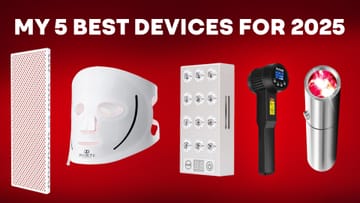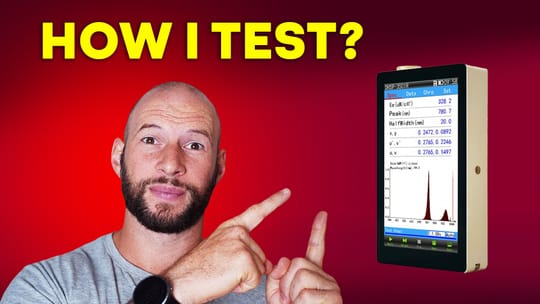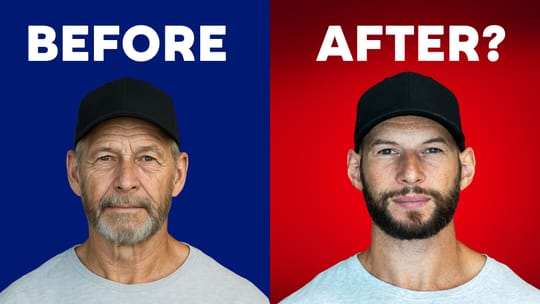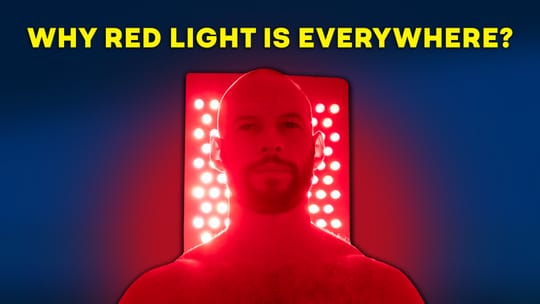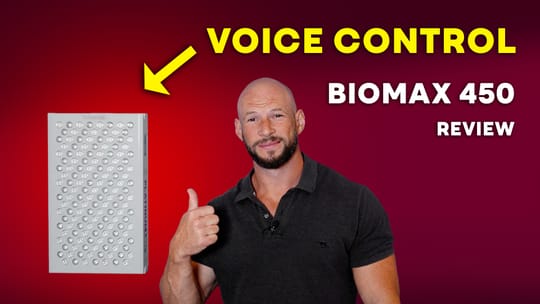Keeping up with red light therapy news and updates can feel like drinking from a firehose. New devices, new studies, and an avalanche of Black Friday offers arrive every year. This month’s roundup focuses on what actually matters: product launches worth watching, research that changes how we think about sunlight and cardiovascular health, and practical advice for navigating the upcoming sale season without getting overwhelmed.
What’s New This Month? Devices That Made Me Pause
There are two trends worth noting. First, companies are finding creative ways to deliver photobiomodulation to specific tissues. Second, established brands are iterating on familiar products, tightening fit, and adding targeted wavelengths. Both matter, because how a device is applied—and where it is used—can determine the results.
Bon Charge Red Light Therapy Toothbrush

For Bon Charge, the discount code ALEX saves.
A toothbrush that also emits 660 nm red light and 850 nm near infrared is an idea that sticks in the mind. The Bon Charge device gums proximity. Intensity is low compared to full panels, but for oral tissues, low energy can be enough.
Practical notes:
- Wavelengths: 660 nm (red) and 850 nm (near infrared).
- Session length: One to two minutes per brushing is plausible, but effectiveness depends on the delivered dose and frequency.
- Cost and upkeep: The device retails at a premium, and replacement heads add recurring cost.
Why this matters: targeted light to the gums can reduce inflammation and improve healing. Many people saw dramatic improvements in gum pain and tooth sensitivity when they started using the full panels. Hence, a toothbrush that delivers therapeutic wavelengths close to the source is an intriguing, compact option. A proper review and dose calculation will clarify whether the toothbrush hits an effective therapeutic window.
Bon Charge also has an article on the product.
CurrentBody Masks: MultiLight and Acne Series 2
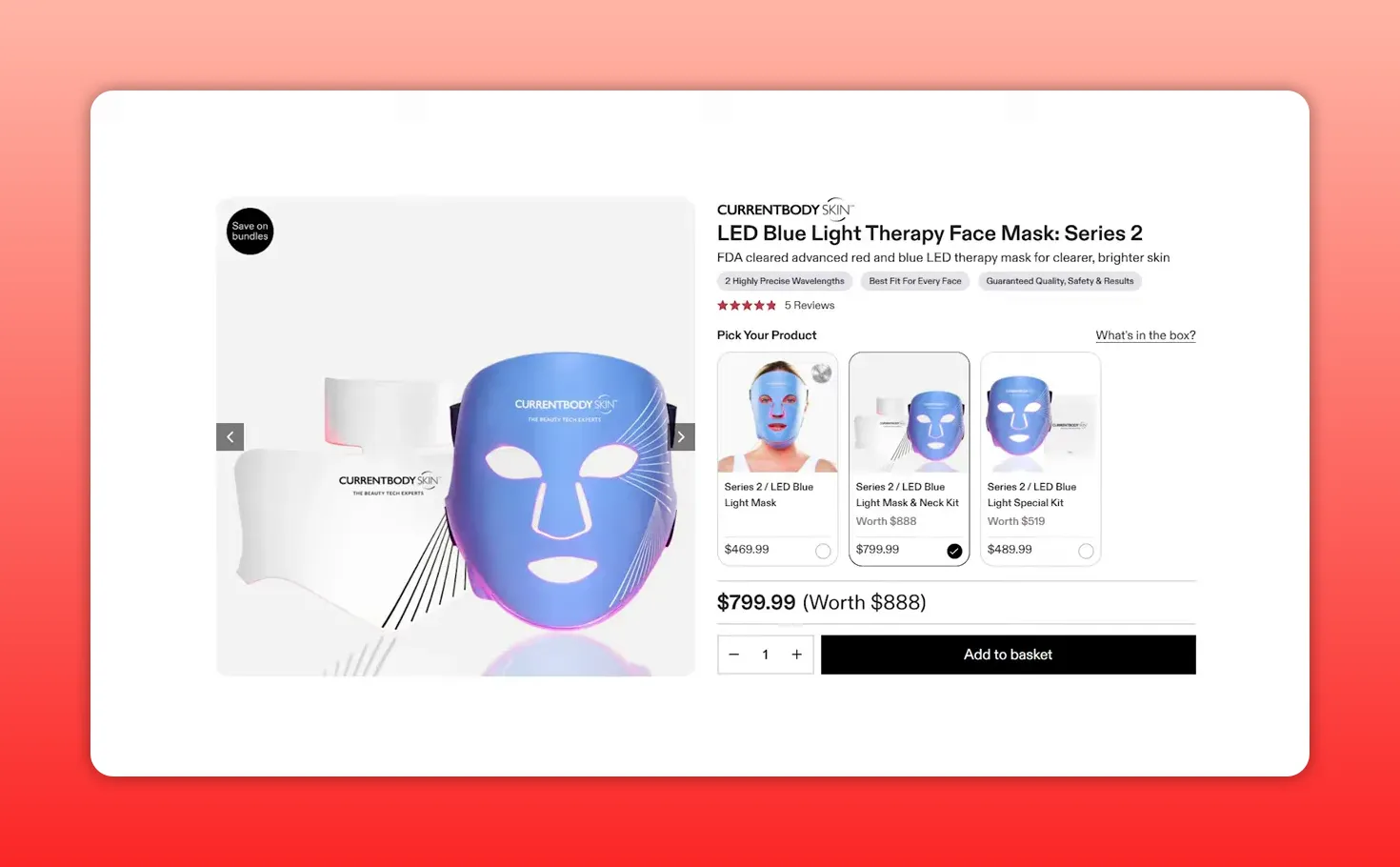
CurrentBody Mask (use code ALEXFERGUS to save) has updated its lineup with a MultiLight option and an Acne Series 2, which includes a chin strap and some ergonomic tweaks. These are modern iterations on masks that combine red and blue wavelengths to target skin rejuvenation and acne-prone inflammation.
Key practical differences:
- The Acne Series 2 focuses on coverage including lower-face areas.
- MultiLight attempts to combine different wavelengths to broaden the effect profile for surface and slightly deeper tissues.
- Ergonomic improvements matter because mask fit affects dose delivery and user compliance.
If you’re considering a mask for acne or skin tone, look not just at watts or diode counts but at fit, wavelength mix, and the recommended protocols for frequency and duration.
JOVS Red Light Therapy Underwear
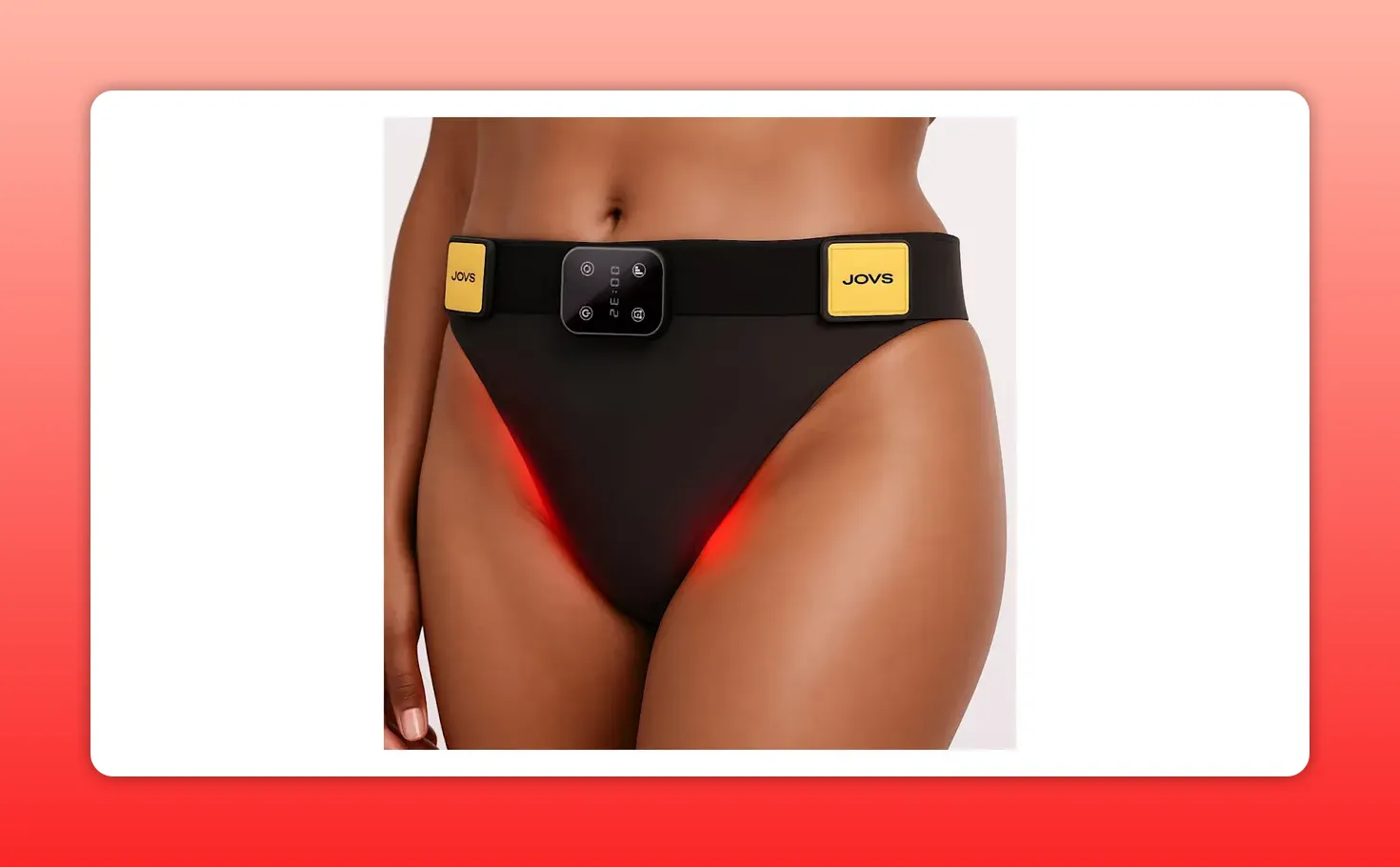
(Click the JOVS link to save with discount code ALEX!)
Yes, light therapy underwear exists. Designed for female reproductive health and cosmetic benefits, these garments aim to deliver light to pelvic tissues. The product highlights a broader point: companies are seeking niche, body‑part specific products that make photobiomodulation conveniently wearable.
Practical considerations:
- Targeted light wearables are an answer to convenience, but effective dosing and comfort are essential.
- A traditional panel session still delivers high fluence to many areas quickly, while wearables promise discreet, portable treatments.
Ultimately, the best device is the one that you will use consistently and that delivers a known therapeutic dose to the intended tissue. If you prefer privacy and discretion, a wearable might fit your routine. If you want the highest power in the shortest time, a panel is still best.
Research highlight: UVA exposure and heart attack seasonality

A recent study examined seasonality patterns in over 56,000 myocardial infarctions across Scotland between 2000 and 2011. Most people associate sunlight benefits with UVB and vitamin D synthesis. This research highlights how UVA, independent of UVB, may play a role in cardiovascular events.
Key findings:
- Heart attacks peaked during winter and were lower in summer.
- About 4% of all heart attacks in the dataset could be statistically explained by changes in UVA exposure—roughly 15 cases per year in Scotland.
- The mechanism proposed involves UVA-triggered nitric oxide release from skin stores, which helps lower blood pressure and improve vascular function.
Why this is useful: the study underscores that not all sunlight benefits are mediated by vitamin D. UVA appears to have direct vascular effects through nitric oxide mobilization. For people who cannot get regular sun exposure, the study strengthens the case for considering devices that mimic broad-spectrum sunlight or otherwise help improve vascular health through safe, non-UV approaches.
Dosing, Cognition, and Where to Look For Deeper Reading
Dosing remains one of the most complex topics in photobiomodulation. A few resources and studies are worth bookmarking if you want to go deeper.
- Dosing variability: Higher dosing is not always better. There are diminishing returns and potential biphasic responses where too much light reduces benefit.
- Cognitive photobiomodulation: Some companies publishing new fMRI and EEG data are expanding our understanding of how transcranial near-infrared light affects brain activity. This is an area where controlled clinics and devices designed for cognitive health show promise.
- Practical takeaway: Match device power and wavelength to the target tissue, and follow protocols grounded in peer-reviewed work when possible. For serious conditions, a clinical provider or specialised clinic is the right call.
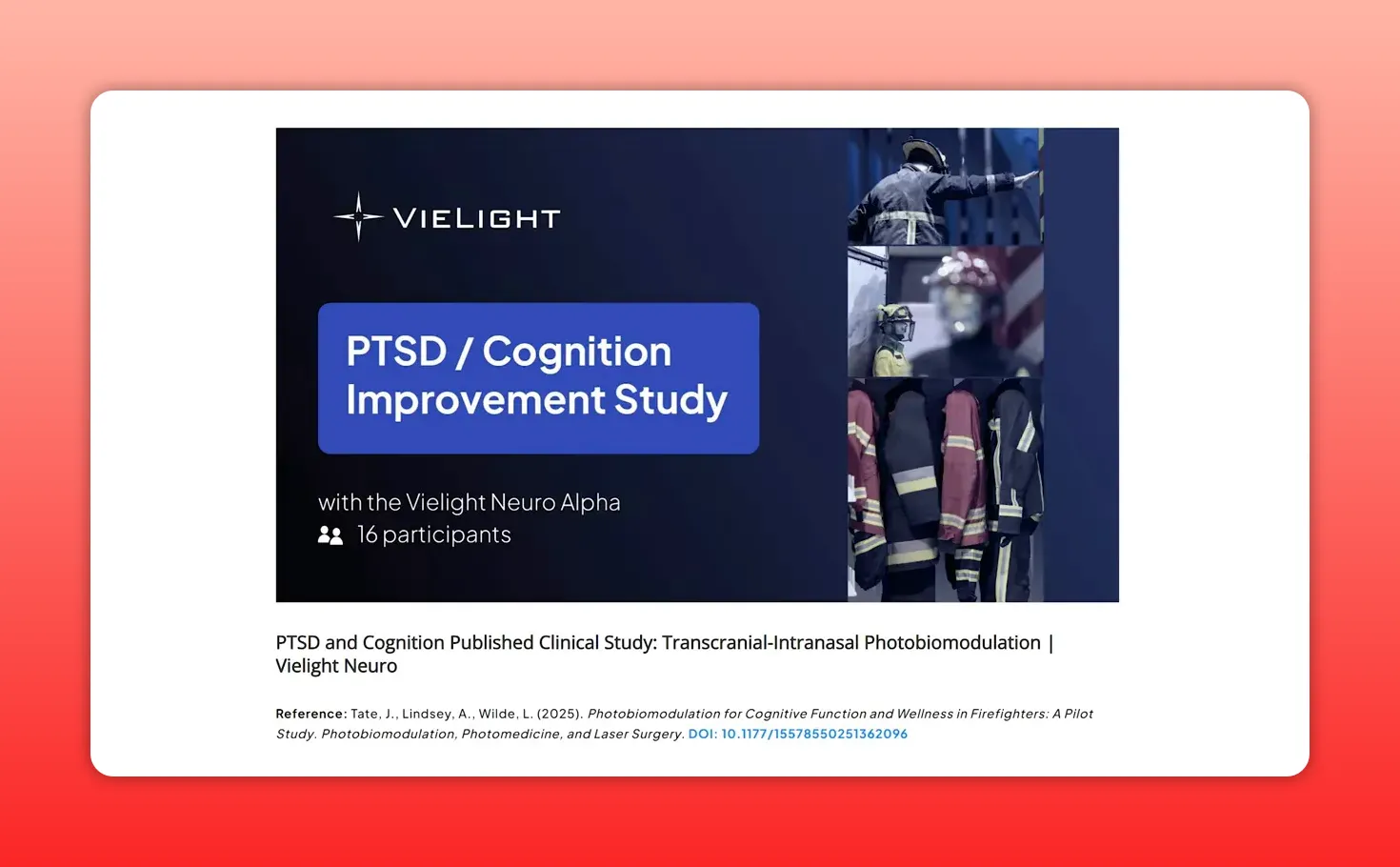
There are excellent write-ups and deep dives on dosing. If you are trying to figure out a protocol for a mask, a panel, or a smaller wearable, look for resources that translate joules per cm² into real-world session times for your device. That will avoid underdosing or wasting time on negligible treatment.
Community Pulse and The Direction For 2026
Community feedback has shaped priorities. With a 25,000-strong group sharing questions and experiences, two key goals have emerged for the coming year:
- Help people find devices that match their needs, not just the latest hype.
- Help people use devices more effectively by translating science into practical, easy-to-follow protocols.
This means more buyer’s guides, clearer product recommendations, and expanded protocol content. The aim is to move beyond “buy this” to “buy this for these reasons and follow these steps to make it work.” That approach matters because many conditions respond better to consistent, correctly dosed therapy rather than sporadic experimentation.
Black Friday and How to Shop The Deals

Black Friday can be an opportunity to get excellent value, but it also creates noise. Several simple strategies help you take advantage of the sales without buyer’s remorse.
How to prioritise purchases
- Identify needs: Are you after a full-body panel, a face mask, or a targeted wearable? Top priorities should address the most pressing goals first.
- Compare effective cost: Consider both initial price and running costs like replacement heads or limited-lifetime diodes.
- Check real discounts: Some deals are sitewide while others are limited bundles. Look for stackable offers that combine manufacturer discounts with exclusive codes for the best saving.
Get Exclusive Black Friday Red Light Therapy Deals
Join our insider list for subscriber-only access to the biggest discounts of the year — up to 50% off top panels, masks, and devices trusted by thousands.
👇
Unlock Black Friday DealsSubscriber-only • Biggest discounts • Trusted brands
Notable deals this season
While discounts vary by brand and timing, a few highlights to watch for:
- Rouge typically offers deep sitewide discounts on panels—where a mid-range buy can become an excellent long-term investment.
- Kineon and similar brands sometimes run exclusive, high-percentage discounts on flagship products.
- Mask brands often discount single units and bundles; look for reputable masks with solid fit and recommended protocols.
Pro tip: If an exclusive code is available, it may only be shared through a curated list. Signing up for a focused newsletter or joining an active community will often surface the best stackable offers before public coupon sites catch them.
What to Expect in Upcoming Reviews and Coverage
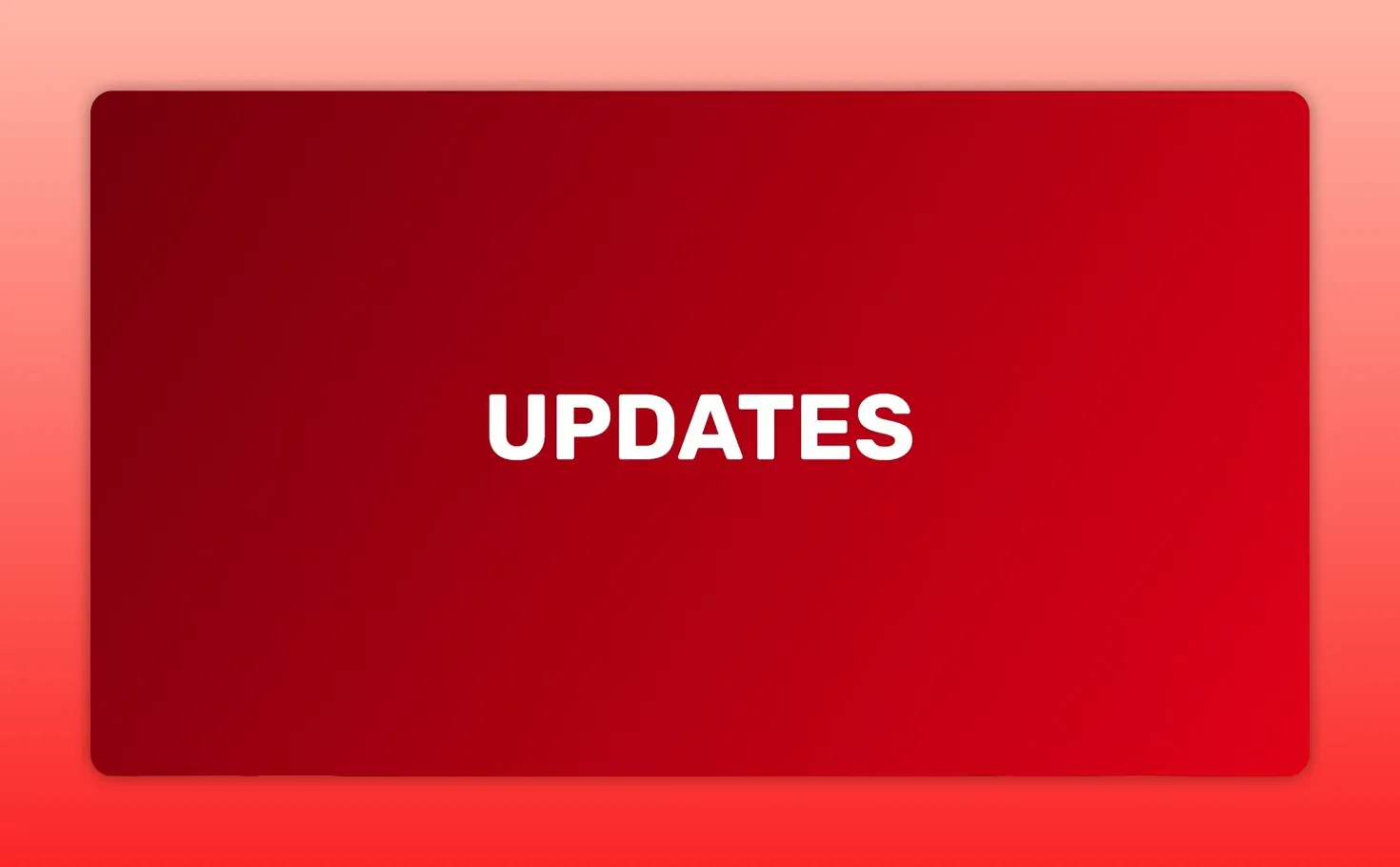
Upcoming content will focus on first impressions and in-depth reviews that combine hands-on experience with dosing analysis. Expect:
- Head-to-head mask comparisons that emphasise fit, power, and clinically relevant wavelength mixes.
- A recommendations video on which panel to buy this holiday season that balances design, features, and discounted pricing.
- Practical guides translating joules per cm² into session time for common devices so you can compare apples with apples.
One particular mask under $120 impressed in initial testing and is scheduled for a full review. If it drops under $100 for Black Friday, that represents a rare combination of performance and price in the mask category.
Simple rules for buying and using photobiomodulation devices
Whether this is your first device or your fifth, use these rules as a checklist before hitting purchase:
- Define the target: Face, joint, muscle, oral tissue, or brain? The target determines the ideal wavelength and device form factor.
- Match wavelength to tissue depth: Red light (around 660 nm) is great for skin and superficial tissues; near-infrared (around 850 nm) penetrates deeper.
- Calculate dose: Check the device’s irradiance and compute session time to hit a therapeutic joules per cm² range.
- Prioritise fit and coverage: Especially for masks and wearables, a good fit ensures consistent dosing. Poor fit undermines even the most powerful device.
- Think long-term: Consistent use over weeks to months produces results. One-off sessions rarely change chronic conditions.
Useful Community Actions and Credibility

Community input accelerates learning. Leaving short product reviews and honest feedback on trusted review platforms helps other buyers cut through marketing. Similarly, joining an engaged forum or group gives access to practical tips, exclusive discount opportunities, and protocol refinements from people with real-world experience.
Rate us on Trustpilot.
"We're trying to help people find the best red light therapy device for their needs and also help them use the best device."
Final Thoughts and Next Steps
This month shows how quickly the landscape continues to evolve. Wearables and targeted products expand options, while research on sunlight’s vascular effects keeps reminding us of the broad biological impact of light. If you want practical, evidence-based guidance:
- Prioritise devices that meet your specific goals.
- Focus on dosing and fit rather than marketing claims.
- Keep an eye on exclusive deals if you are shopping Black Friday; sign up for a curated list to see stackable offers.
Red light therapy news and updates will keep coming. The highest-impact choices will always be those that match device design and protocol to a real need, supported by a community that tests, measures, and shares results.
Actions you can take today
- Decide on your primary treatment goals and budget.
- Check recent dosing guides and calculate expected session times for candidates.
- Join an active community for early access to exclusive offers and real-world feedback.
Expect more hands-on reviews, deeper protocol guides, and a Big Black Friday summary to help you choose wisely. The goal is simple: clearer choices, better use, and fewer costly mistakes as you explore the evolving world of photobiomodulation.
Here Are All The Masks Mentioned In This Article:
🔥 Bon Charge Red Light Therapy Toothbrush
https://aferg.co/red-toothbrush
🔥 CurrentBody LED Masks, MultiLight Mask and Blue Light Acne Mask Series 2
https://aferg.co/cb-mask
🔥 JOVS Red Light Underwear Device
https://aferg.co/jovs
🔥 Hooga Red Light Therapy Mask (or any Hooga product) – 12% OFF auto-applied: https://aferg.co/hooga-rlt
🔥 Rojo Refine Oro / Rojo Dorada – use code ALEX:
https://aferg.co/rojo-rlt
🔥 NanoLeaf LED Face Mask – use code ALEX10 for 10% off:
https://aferg.co/nanoleaf
🔥 Project E Beauty LumaLux Mask – use code ALEX15 for 15% off:
https://aferg.co/projectebeauty
🔥 HigherDose Mask – use code ALEX, save up to 20%:
https://aferg.co/higherdose
🔥 MitoRed MitoClear LED Face Mask – discount auto-applied:
https://aferg.co/7d221
🔥 Qure Q-Rejuvalight Pro Mask – 10% off auto-applied:
https://aferg.co/Qure
🔥 Block Blue Light Face Mask – 15% off auto-applied:
https://aferg.co/blockbluelight
🔥 Megelin Laser & LED Mask – use code ALEX for 5% off:
https://aferg.co/megelin
🔥 Maysama PRANA LED Mask – use code ALEX for 10% off:
https://aferg.co/maysama
🔥 Therabody Theraface Mask – no discount code:
https://aferg.co/therabody
🔥 Lumara Viso Mask – use code ALEX50 to save $50:
https://aferg.co/lumara
🔥 Infraredi LED Light Therapy Mask – 25% OFF + gifts with code ALEX:
https://aferg.co/infraredi
🔥 AMIRO Spectra 5-in-1 Mask – use code 70ALEX to save $70:
https://aferg.co/amiro
🔥 iRestore Illumina Mask – no discount (yet):
https://aferg.co/irestore
Found This Interesting? Look At These Articles
🔴 The Red Light Therapy Facial Fat Loss Link: Myth Or Reality?
🔴 Does Red Light Therapy Help Scars? The Science
🔴 Red Light Therapy For Skin: Beauty Benefits, Potential Complications, And More
🔴 Psoriasis With Red Light Therapy: Potential Game-Changer?
Have You Seen These Reviews
🔴 Rouge G4 Pro Review: Most Advanced Red Light Panel Yet?
🔴 Best Red Light Panel Yet? Block Blue Light Mega Review
🔴 $800 Red Light Mask Has Lasers… But Why?
🔴 Omnilux Contour Mask Review: Still Worth It in 2025?
Alex's Bio
Alex Fergus wrote this blog post. Alex is an ISSN Sports Nutrition Specialist, Fitness Professional, and certified Superhuman Coach who continues to expand his knowledge base and help people worldwide with their health and wellness. Alex is recognized as the National Record Holder in Powerlifting and Indoor Rowing and has earned the title of the Australian National Natural Bodybuilding Champion. Having worked as a health coach and personal trainer for over a decade, Alex now researches all things health and wellness and shares his findings on this blog.


